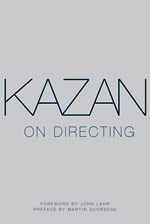(Knopf Publishing, 368 pages, $30)
By Elia Kazan, edited by Robert Cornfield
 Kazan on Directing is a deftly assembled collection of the great director’s instructions to his theater and film collaborators. Included are character biographies, costume suggestions and staging setups, as well as some often brutally frank postmortem examinations of his work. The selections are mostly from his notebooks, but also from interviews and speeches. This is Kazan the professional speaking, a giant of the Method spilling his secrets. We are granted admission to the inner sanctum, and made privy to his creative process in the most intimate details.
Kazan on Directing is a deftly assembled collection of the great director’s instructions to his theater and film collaborators. Included are character biographies, costume suggestions and staging setups, as well as some often brutally frank postmortem examinations of his work. The selections are mostly from his notebooks, but also from interviews and speeches. This is Kazan the professional speaking, a giant of the Method spilling his secrets. We are granted admission to the inner sanctum, and made privy to his creative process in the most intimate details.
Kazan, as editor Robert Cornfield notes, “would have been the first to protest [that] ‘directed by’ is a meanly limited, misleading term for his contribution to the plays and movies he commanded.” Kazan (the name means, essentially, and appropriately, “cauldron”) kept a tight rein on his collaborators—wardrobe people, production designers, editors—all of whom were favored with extended missives outlining the director’s vision of their contributions. He reshaped masterpieces by Williams and Miller, and ruthlessly manipulated his actors, even setting them against each other. He often “tricked” great performances from his cast, and wasn’t above slapping an actor to make the tears roll.
At the same time, Kazan could extend profound imaginative sympathy toward his actors and their roles, evident by his lengthy letter to Marlon Brando setting out his ideas on how to play Terry Malloy in On the Waterfront. Part of it effectively summarizes Kazan’s Freud-inflected approach to character: “I really hope to be photographing the kid’s insides as much as exterior events.” As represented here, Kazan’s theories of direction are simple and brutal: “There is only one way of looking at this trade: The filmmaker is responsible for everything. To rephrase that thought: Everything is your fault.” Or more tersely: “It’s a question of power, nothing less.”
Although excerpts from many of the entries have appeared elsewhere over the years, Kazan’s workbooks and interviews collected in one volume are an indispensable resource for anyone hoping to understand the direction of actors (Brando, James Dean, and Lee J. Cobb among them), and the differences between stage and screen direction in the molten middle of the 20th century. One quibble, however: Cornfield’s decision to separate Kazan’s film and stage work deprives the book of a sense of the director’s chronological creative growth across both mediums. Styles may have changed, but Kazan still has plenty to say about directing that remains revelatory and instructive today.
Review written by John Patterson.